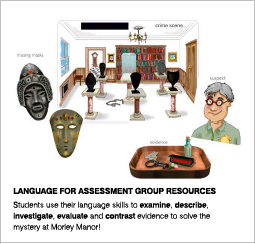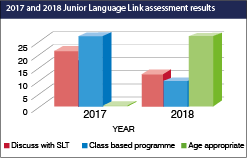Understanding and using language is fundamental to being included in today’s service industry society, with access to the jobs market increasingly dependent on strong communication skills. Yet upwards of 10% of all children present with speech, language and communication needs (SLCN). This number rises sharply for young people growing up in areas of social deprivation with as many as 50% not having adequate communication skills to interact effectively with those around them.
As these young people progress through school, their language problems can be disguised as poor behaviour, weak literacy or learning difficulties. Sadly, the long-term impact of unaddressed language needs is far reaching; leaving students more at risk of exclusion from school, long term unemployment and a higher risk of falling into criminality.
With numbers increasing, school budgets under pressure and restricted access to support services, schools can feel overwhelmed by this challenge. The good news is that, with the right tools and guidance, schools will be empowered to support these pupils.
Much attention is paid to supporting children at school entry through early intervention programmes. However, many children’s language difficulties can remain hidden until they begin their Junior education. As language demands increase with the curriculum, some higher level language difficulties become apparent, e.g. making inferences, understanding idiomatic language and social understanding. Unless schools continue to monitor children’s understanding through the junior and secondary years they run the risk of misidentification and lose valuable time that could be spent supporting the young person’s underlying language needs.
Poor behaviour: ‘We don’t have students with language difficulties, it’s behaviour that concerns us.’
Lack of resources: ‘Sadly, even when language needs are identified, in this climate we don’t have the resources or expertise to support them.’
No access to training: ‘Our Senior Leadership Team expect teachers to meet the needs of all students with SLCN but how can schools equip staff with these skills?’
81% of children with emotional and behavioural difficulties have underlying language problems. (ICAN Impact Report 2016/2017)
The Solution
This award-winning online package combines a standardised assessment, targeted interventions with measured outcomes and resources for teachers and parents. It enables schools to identify and support effectively the language and communication needs of students aged 7 to 11 years, to boost attainment and improve life changes. The package also helps to prepare them for transition to secondary education.
 Standardised Assessment
Standardised Assessment
The online standardised assessment helps schools identify where language difficulties are underpinning poor behaviour or under-achievement. Fun, quick and easily accessible, it screens children’s understanding across key areas appropriate for their age. Instant results will identify who needs specialist support and recommend appropriate class and small group interventions so you can target help at the right level.
 Intervention
Intervention
Junior Language Link provides planned and resourced interventions for a graduated approach to supporting children. Our whole class strategies allow the teacher to support the development of speech and language universally. Our fully resourced language groups allow support staff to provide targeted interventions.
 Help Desk and Training
Help Desk and Training
Our dedicated and friendly Help Desk of Speech and Language Therapists, Teachers and Teaching Assistants is there to help, whether it is advice on how to find resources or what to do next.
We provide a range of training options for ALL teaching and support staff. In-package training leads staff through these powerful tools to get you up and running straight away. Our webinar sessions with Speech and Language Therapists allow staff to embed good practice throughout the school and make the most of the all the data the package provides.
Key Areas of Language
Grammar:
– Verb Tenses
– Negatives
– Complex Sentences
Vocabulary:
– Concepts
– Association
Meaning:
– Figurative Language
– Narrative Inferences
Identify those with difficulty accessing the curriculum.
Identify students at risk of social exclusion.

Language for Assessment Group Resources:
Students use their language skills to examine, describe, investigate, evaluate and contrast evidence to solve the mystery at Morley Manor!
Case Study: The Scarborough Pledge Initiative

Background
In 2015, following an education summit, the Scarborough Pledge was created to improve the life chances, ambitions and outcomes for young people in the area. One of the projects to come out of this initiative was to develop a model of good practice in schools to support Speech and Language development.
Braeburn school is a two form entry school. Staff there have used Junior Language Link since it was introduced as a pilot project in 2016 as part of the Scarborough Pledge initiative.
To investigate the impact of Junior Language Link we analysed the assessment results over a two year period.
Participants
All children were included in the study who were assessed during 2017, took part in intervention and were then re-assessed in 2018. 44 pupils from years 3-6 fulfilled these criteria.
The Intervention
The children all took part in Junior Language Link intervention groups as recommended following the assessment. All the groups were run by teaching assistants. Each group ran for 8 x 30 min sessions. Some children attended a single group whereas others attended several groups between assessments. Each group had a slightly different focus but all were aimed at improving the children’s listening and understanding of spoken language.
The Results
The results were overwhelmingly positive. At the beginning of the study 44 pupils were identified as needing support with 19 of them needing advice from an outside agency. At the second assessment 25 children no longer needed support and only 11 continued to need outside agency support.


We contacted Executive Head Teacher, Vicki Logan, to find out what she thought about the impact of using Junior Language Link.
“This initiative has had a very positive impact on the language and communication development of Braeburn children. Teachers report that children are more confident with their speaking and that listening capacity has also improved. Outcomes from the interventions demonstrate high levels of success and the numbers requiring ongoing support has declined. Reading results tripled for the end of KS2 and from 2016 to 2018 which is excellent. In addition to this, Early Years GLD outcomes improved by 50% from 2016 to 2018, another outcome to celebrate.”
Making a difference
“A Year 5 girl went all the way through the school but without making the expected progress. No-one was sure why. We used the Junior Language Link assessment and she came out as significantly impaired – everyone was really surprised. She was struggling with the complexity of the language and was struggling to retain instructions. We completed a Listening group and a Concepts and Instructions group. She was assessed by the Speech and Language Therapist and has made good progress. It [the assessment and interventions] has boosted her self-esteem. Before she didn’t know why she was finding it so hard compared to the others in the class: now she understands why it was so hard. She feels like she’s being helped now and enjoys the interventions.” Aldermoor Farm School
“Helps to differentiate between a real concern and what’s just ‘nothing to worry about’. It can put parents’ minds at rest.” Fleetdown Primary School.

ERA Award Winner 2018: Junior Language Link
Primary Resource for Leadership, Management and Assessment. The judges said:
“Highly impressed – the platform not only offers opportunities to track and trace student progress, but also provides well-designed suggestions and strategies for teacher intervention.”
Please login to view this content
Login